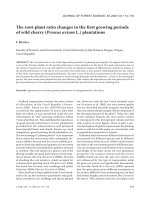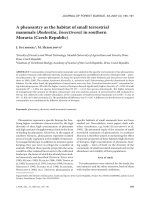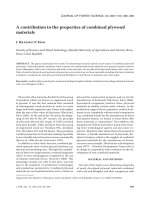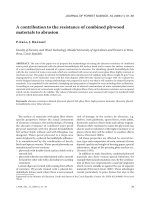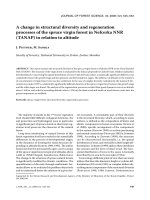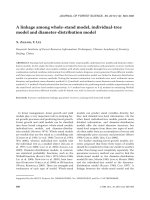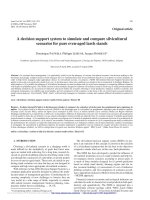Báo cáo lâm nghiệp: "A tree crown ratio prediction equation for eucalypt plantations" ppt
Bạn đang xem bản rút gọn của tài liệu. Xem và tải ngay bản đầy đủ của tài liệu tại đây (160.97 KB, 10 trang )
Original article
A tree crown ratio prediction equation
for eucalypt plantations
Paula Soares* and Margarida Tomé
Department of Forestry, Tapada da Ajuda, 1349 017 Lisboa, Portugal
(Received 3 January 2000; accepted 5 October 2000)
Abstract – Based on a data set from spacing trials and permanent plots of Eucalyptus globulus Labill., several nonlinear equations
for crown ratio prediction (based on exponential, logistic, Richards and Weibull functions) were tested. The total data set was used to
fit and select the equations. The equations were evaluated in terms of measures of fit and prediction ability: adjusted-R
2
, residual
mean square, sum of PRESS residuals and sum of absolute PRESS residuals. The normality of the studentized residuals was analyzed
using normal QQ plots. The presence of heteroscedasticity associated with the error term was checked by plotting the studentized
residuals against the predicted values. The significance of the estimated parameters was verified. Model error was characterized in
terms of bias and precision. The Richards function was selected. This equation is age and density dependent, reflecting the impor-
tance of intertree competition; an initial tree dimension and a measure of stand productivity were also required as explanatory vari-
ables.
crown ratio / tree model / plantations / Eucalyptus globulus Labill.
Résumé – Équation de prédiction du rapport entre longueur du houppier et hauteur totale de l’arbre pour des plantations
d’eucalyptus.
À partir d’un ensemble de données d’essais d’espacement et de parcelles permanentes d’Eucalyptus globulus Labill,
différentes équations de prédiction du rapport entre longueur du houppier et hauteur totale de l’arbre (basées sur les fonctions expo-
nentielle, logistique, Richards et Weibull) sont testées. Les données sont utilisées pour l’estimation et la sélection des équations de
prédiction. L’évaluation des équations est basée sur des mesures d’ajustement et de capacité de prédiction : R
2
-ajusté, carré moyen
des résidus, addition des résidus PRESS et addition des résidus PRESS absolus. La normalité des résidus est analysée par le gra-
phique QQ normal. La présence d’hétéroscedasticité associée à l’erreur est analysée par le graphique des résidus versus les valeurs
prédites. La signification des paramètres estimés est vérifiée. L’erreur du modèle est caractérisée en terme de biais et de précision. La
fonction de Richards est sélectionnée. Cette fonction est dépendante de l’âge et de la densité, exprimant ainsi l’importance de la com-
pétition entre les arbres ; la dimension initiale de l’arbre et une mesure de la productivité du peuplement interviennent aussi comme
variables explicatives.
rapport longueur du houppier-hauteur totale / modèle individuel / plantations / Eucalyptus globulus Labill.
1. INTRODUCTION
Crown dimensions can be important components of
forest growth and yield models, and are used in many
tree and crown level growth–modelling systems [2, 3,
17, 19, 21, 25]. For instance, tree crown parameters can
be considered when simple competition indices are not
able to adequately predict recovery from competition
when a competitor is removed (e.g. by thinning) [23];
tree crown parameters have been used as predictor
Ann. For. Sci. 58 (2001) 193–202 193
© INRA, EDP Sciences, 2001
* Correspondence and reprints
Fax. 351 1 364 50 00; e-mail:
P. Soares and M. Tomé
194
variables in diameter and height growth equations [e.g.
3, 9, 25]; stand crown parameters have also been used to
distinguish different stages of stand development [18].
A tree’s crown reflects the cumulative level of compe-
tition over time [8]. Crown ratio and crown length reflect
the potential of a released tree to use available resources
such as increased growing space [3]. The lack of data
and the difficulty of accurately measuring the height to
the live crown base – more pronounced in species with
asymmetric crowns – may justify the relatively little
research done on modeling crown parameters [17].
Crown dimension modeling is highly dependent on the
accuracy of total height and height to the live crown base
data and/or equations. Predictions of tree crown ratio
have been based on allometric relations between stand
and tree variables [1, 5, 6, 7, 25, 26]. Crown ratio can be
predicted directly from tree and/or stand variables [e.g.
6] or indirectly from estimates of the height to the live
crown base.
The purpose of the present work was to develop a tree
crown ratio prediction equation, that serves as a compo-
nent of a tree model for the first cutting cycle of
Eucalyptus globulus Labill. plantations, located in the
north and central coastal regions of Portugal [18]. This
equation will be used to determine the stand average
crown ratio, an indicator of different competition stages
during stand development.
2. DATA
Eucalyptus globulus Labill. was introduced in
Portugal 150 years ago. It is a fast growing species,
mainly being used by the pulp industry. The trees are
planted at final density, as thinning and pruning practices
are not usual during the first cutting cycle. The stands
are intensively managed as a short rotation coppice sys-
tem in which the first cycle of planted seedlings (single
stem) is followed by 2 or 3 coppiced stands, with an
average cutting cycle of 10–12 years.
Data from permanent plots, three spacing trials and a
fertilization and irrigation experiment of eucalypt were
used. The principal criterion for the selection of these
plots was the availability of tree measurements of the
height to the live crown base (table I). In some of the
plots, the measurements were made on felled trees, but
in most of them they were gathered with a hypsometer.
The base of the live crown was defined as the point of
insertion of the lowest live branch in at least three of the
four horizontal quadrants defined around the stem of the
tree. However, this definition is, in practice, subjective;
when possible, this subjectivity was minimized by main-
taining the same field crew in subsequent measurements
and checking, directly in the field, the values of the
height to the live crown base, comparing them with the
values of the last measurement.
This data set includes 10 and 36 plots respectively
from the Quinta do Paço and the Vilar de Luz spacing
trials [18], two control plots and two fertilized plots of
the fertilized and irrigated trial [12] and 18 permanent
plots. Data from felled trees in 10 plots of the Alto do
Vilão spacing trial and two permanent plots, described
by Pedro [11] and Tomé [20], were also used. Individual
tree leaf area was estimated [13]. In the stands where the
height to the live crown base of all the trees were mea-
sured, the leaf area index (LAI) was defined as the ratio
between the total leaf area and the plot area. When only
a sample of trees was measured, LAI was calculated by
multiplying the mean leaf area by the number of trees in
each plot and dividing by the plot area.
From the available measurements of individual trees,
those from border trees, trees without simultaneous mea-
surements of total height, height to the live crown base
and diameter and trees with height and/or diameter
imperfections were eliminated.
3. METHODS
3.1. Candidate models
A crown ratio equation must be bounded so that the
crown ratio prediction values lay between 0 and 1. Many
authors have based crown ratio equations on the logistic
function [6, 14] or the exponential function [4, 5, 7]. In
this work, the Richards function and the cumulative
distribution of the Weibull function were also tested
(table II).
The linear function X (see table II) was expressed as a
combination of age, tree dimension (diameter, height,
height/diameter ratio), stand density (number of planted
trees or live trees ha
–1
, basal area), maximum tree dimen-
sion (diameter), mean tree dimension (diameter, domi-
nant diameter) and site productivity (dominant height,
site index). The inverse of each of these variables was
also tested. The number of variables was restricted by
the presence of only one from each group. Each function
was tested in different versions defined by the linear
function of tree and stand variables (X). As an explorato-
ry analysis, an all-possible-regression algorithm, with
crown ratio as dependent variable, was used to select
combinations of variables to express crown ratio. This
selection was based on measures of multiple linear
regression quality and prediction ability: adjusted-R
2
,
residual mean square, sum of PRESS residuals and sum
of absolute PRESS residuals [10]. The presence of
A tree crown ratio equation for eucalypt
195
colinearity was analyzed on the basis of the values of the
variance inflation factors (VIF); values up to 10 were
accepted [10].
3.2. Model fitting and selection
Model fitting and evaluation are important parts of
model building. In this work, the total data set was used
to fit and select the tree crown ratio equations. The eval-
uation was based on the prediction errors or PRESS
residuals.
Different versions of the exponential, logistic,
Richards and Weibull functions were fitted; the parame-
ter estimation of these nonlinear functions was based on
the least squares method associated with the PROC
NLIN procedure of the SAS/STAT [16]. The modified
Table I. Characterization of the plots used for the definition of the crown ratio prediction equation.
spacing trials permanent plots
AV QP VL FR PP Pedro (1991) Tomé (1997)
plot characteristics
plot area (m
2
) 1584–2464 648–2916 470–2475 1089 243–780 2916 1006
spacing (m
×m) 3×2–5×42×1–3×32×1–4×43×3 1.7×1.7–3.3×3.2 3×33×3
site index 20.4–23.7 25.7–28.4 19.7–25.8 23.3–28.1 12.6–26.8 23.3 22.6
number of remeasurements 1 4 7 3 4 1 1
age (years) minimum 17.9 4.6 1.8 2.0 1.3 5.3 6.7
mean 17.9 6.1 2.8 3.1 4.6 5.3 7.3
maximum 17.9 7.6 4.8 4.3 8.3 5.3 7.9
nº trees/plot minimum 5 39 56 79 17 324 18
mean 5 50 61 82 38 324 18
maximum 5 61 65 86 85 324 18
d (cm) minimum 7.2 1.2 0.2 4.2 0.4 3.2 8.1
mean 20.7 11.9 6.2 11.3 7.6 12.6 14.0
maximum 33.2 23.9 22.8 19.7 22.1 22.3 18.7
h (m) minimum 10.0 3.0 1.1 4.1 1.4 5.7 14.7
mean 23.6 16.8 7.8 11.0 9.4 13.3 17.6
maximum 30.5 26.8 20.0 16.9 26.5 19.5 22.2
hbc (m) minimum 7.8 2.7 0.0 0.1 0.2 1.3 4.5
mean 17.7 10.5 2.6 3.4 3.9 3.9 6.6
maximum 25.6 19.5 13.6 7.2 14.7 7.6 10.0
cl (m) minimum 0.9 0.0 0.2 3.2 0.4 2.5 7.8
mean 5.9 6.4 5.6 7.6 5.5 9.4 11.0
maximum 16.5 14.5 12.9 12.4 16.0 15.2 14.9
cr minimum 0.05 0.00 0.08 0.46 0.11 0.34 0.50
mean 0.25 0.37 0.72 0.71 0.59 0.70 0.62
maximum 0.60 0.80 1.00 0.99 0.98 0.90 0.75
la (m
2
) minimum 4.05 0.29 0.01 4.31 0.03 2.48 10.85
mean 23.20 17.01 10.27 29.41 14.67 38.13 36.43
maximum 64.49 71.32 100.18 71.85 117.91 107.28 62.36
LAI minimum 1.21 1.79 0.13 1.73 0.18 3.62 3.26
mean 1.68 2.68 1.60 3.23 2.12 3.62 3.26
maximum 2.15 3.76 3.93 4.70 3.80 3.62 3.26
AV, QP and VL, Alto do Vilão, Quinta do Paço and Vilar de Luz spacing trials, respectively; FR, fertilization and irrigation trial; site index, mean
height at base age 10 years; d, tree diameter at breast height; h, total tree height; hbc, tree height to the live crown base; cl, tree crown length; cr, tree
crown ratio; la, tree leaf area; LAI, leaf area index.
P. Soares and M. Tomé
196
Table II. Functions tested and restrictions imposed to the parameters on the prediction of tree crown ratio.
function restrictions
exponential
A, c, k = 1
logistic
A, c, k = 1
Richards
A, c, k = 1
m = 6 *
Weibull
A, c, k = 1
w = 10 *
y, tree crown ratio; X, linear function of tree and stand variables; A, asymptote; c, k, m and w, function parameters; *, defined on
point 4.2. of this work.
y =A 1–c e
– kX
w
y =
A
1+c e
– kX
1/m
y =
A
1+c e
– kX
y =A 1–c e
– kX
A tree crown ratio equation for eucalypt
197
Gauss-Newton iterative method was applied in model
fitting. The PROC MODEL procedure of the SAS/ETS
[15] was used to analyze the colinearity between the
variables and to ensure that the solution was global
rather than local. Multicollinearity was assessed in terms
of the condition number of the correlation matrix; when
this exceeded 1000, the effect of multicollinearity was
considered serious and the model discarded [10].
The versions of each function were identified and
were evaluated in terms of measures of fit and prediction
ability: adjusted-R
2
, residual mean square, mean of
PRESS residuals and mean of absolute PRESS residuals
[10]. The normality of the studentized residuals was ana-
lyzed using normal QQ plots. The presence of het-
eroscedasticity associated with the error term of the
models was checked by plotting the studentized residuals
against the predicted values. The heteroscedasticity was
only checked graphically because the frequent non-nor-
mality of the studentized residuals makes the use of sta-
tistical tests impracticable [24]. Both the significance
and the stability of the parameters estimated were
ensured based on the asymptotic t-statistics.
3.3. Model evaluation
The evaluation was based on the prediction errors or
PRESS residuals that indicate the predictive ability of
the equations by cross validation [10]. This entails omit-
ting each observation in turn from the data, fitting the
model to the remaining observations, predicting the
response for the omitted observation and comparing the
prediction with the observed value: y
i
– y
^
i,–i
= e
i,–i
(i =
1,2,…, n). The PRESS residuals are true prediction
errors with y
^
i,–i
being independent of y
i
. Each candidate
equation has n PRESS residuals associated with it, and
the PRESS (Prediction Sum of Squares) statistic is
defined as [10]:
The accuracy of the selected functions, in terms of both
bias and precision, was analyzed. Bias and precision
were assessed through histograms of the PRESS residu-
als and computation of the mean of the PRESS residuals
(bias) and the mean of the absolute PRESS residuals
(precision). Average model bias measures the error when
several observations are combined by totaling or averag-
ing, and mean absolute difference measures the average
error associated with a single prediction [22]. The
interquantile range of the PRESS residuals (Q99-Q1)
was also computed as a measure of precision. Plots of
observed values over predicted values were also ana-
lyzed.
The modelling efficiency was computed; this statistic
provides a simple index of performance on a relative
scale, where 1 indicates a perfect fit, 0 reveals that the
model is no better than a simple average, and negative
values indicate a poor model indeed [22].
4. RESULTS AND DISCUSSION
In the data set, the lack of crown ratio data in stands
more than 8 years old was evident (figure 1). In fact,
height to the live crown base is not measured in current
forest inventory; most of the crown ratio data was
obtained from spacing trials or permanent plots integrat-
ed in a special schedule of measurements. The large
range of the crown ratio values in each age reflects the
effect of stand density and site productivity; this varia-
tion was also observed when the data was analyzed at
stand level, in spite of the fact that these stands are even-
aged monocultures.
4.1. Candidate models
The all-possible-regression algorithm applied to the
total data set resulted in variation inflation factors (VIFs)
greater than 10 with combinations of 5 and 6 variables.
As a consequence, the number of independent variables
PRESS= y
i
– y
i,–i
2
= e
i,–i
2
.
Σ
i =1
n
Σ
i =1
n
Figure 1. Relation between tree crown ratio and age on the
total data set (nobs = 19041).
P. Soares and M. Tomé
198
used in the X function was restricted to 3 or 4. The com-
binations of variables that showed a good performance in
the all-possible-regression algorithm were tested in order
to select the best nonlinear model – exponential, logistic,
Richards or Weibull function.
4.2. Model fitting and selection
Table III presents the selected versions of the expo-
nential and logistic functions. Both were age dependent
(with best results with the inverse of age); the number of
live trees, instead of the basal area, expresses the stand
density; and the initial tree dimension was an important
variable to define the tree crown ratio. In the logistic
function the productivity was best expressed by the dom-
inant height.
Convergence problems were detected in the fitting of
the Richards and Weibull functions when the parameters
were not restricted. To estimate m and w parameters,
associated respectively with the Richards and the
Weibull functions, it was decided to test a set of fixed
values of these parameters. The parameter estimates of
the best versions of the logistic and exponential func-
tions were used as initial values. The m and w corre-
sponding to the smallest residual sum of squares were
selected: Richards function, m = 6; Weibull function,
w = 10.
Four functions were selected, designated as E: expo-
nential, L: logistic, R: Richards and W: Weibull
(
table III).
The hypothesis of normality of the studentized residu-
als was rejected for all functions. However, the normal
QQ plots did not present strongly stressed asymmetries.
These plots were also used to detect outliers; when iden-
tified as measurement errors, handwriting or computa-
tion typing errors they were corrected.
Figure 2 shows the graphic relationship between the
studentized residuals and the crown ratio estimates
obtained with the E, L, R and W functions. For the L, R
and W functions, a systematic variation of the residuals
was not observed, although a greater dispersion associat-
ed with the smaller predicted values was evident. Lower
crown ratio values characterized old stands (where the
measurements of the total height and the height to the
live crown base are more difficult and less accurate) or,
in the same stand, the suppressed trees. The E function
suggested a slight decreasing tendency.
Figure 2 allows the identification of plots or sets of
plots characterized by an abnormal relation between the
observed crown ratio values and the stand characteristics
(e.g. age, site index and density). All these plots were
checked, and maintained when the veracity of the crown
ratio values was proven. The early measurements of one
of the spacing trials – Vilar de Luz – contributed many
of these observations: trees of the wider spacings did not
Table III. Tree crown ratio equations selected: exponential (E), logistic (L), Richards (R), Weibull (W) (n = 19041).
function adj-R
2
RMS min. max.
0.74 0.011 –0.08 0.93
0.76 0.010 0.16 0.96
0.77 0.010 0.23 0.99
0.77 0.010 0.17 0.99
t, age; N, number of trees ha
–1
; ddom, dominant diameter (cm); hdom, dominant height (m); d, tree diameter at breast height (cm); RMS, residual
mean square; min., minimum tree crown ratio predicted value; max., maximum tree crown ratio predicted value.
E:cr=1–e
– 3.82724
1
t
– 0.08693
N
1000
– 0.01551 ddom +0.02969 d
L: cr =
1
1+e
– – 1.05195 +6.01605
1
t
– 0.13592
N
1000
– 0.04759 hdom +0.07236 d
R: cr =
1
1+e
– – 5.76111 +12.33413
1
t
– 0.27179
N
1000
– 0.17543 hdom +0.20559 d
1/6
W:cr=1–e
– –0.91024 +0.36370
1
t
– 0.01036
N
1000
– 0.00405 ddom +0.00502 d
10
A tree crown ratio equation for eucalypt
199
yet show a rise of the base of the crown and the crown
ratio values equalize the asymptote of the functions.
Different densities of the plots of this trial were reflected
in the visual aspect of the limit line that characterized
each one of the graphs in figure 2.
The exponential function estimated negative values,
which were out of the range of admissible values
(
table III). Table II presents the parameter restrictions
used to oblige the crown ratio to always be positive.
However, for the exponential function, X (a linear com-
bination of tree and stand variables) should also be posi-
tive. In the data set, 9 predicted crown ratios (in 19041
observations) were negative as a consequence of a nega-
tive X; these points were identified as corresponding to
trees growing in very dense plots (5000 trees ha
–1
at
plantation) with high values of dominant diameter or to
trees with small diameters growing in stands with high
values of dominant diameter.
In spite of the fact that the crown ratio values predict-
ed by the three functions laid between 0 and 1, the logis-
tic function predicted the lowest maximum values (0.96)
which, according to the characteristics of the total data
set, seemed to underestimate the observed values; the
Richards function predicted the highest minimum values
(0.23), which seemed to overestimate the observed val-
ues (table III). In the total data set, 10.5% of the real
observations were greater than 0.99; null crown ratio
values were observed corresponding mainly to near-to-
death-trees of the closer spacings of the Quinta do Paço
trial. The mean crown ratio of the old stands, represented
by the Alto do Vilão spacing trial, was 0.25 and the min-
imum values predicted by both functions were not inferi-
or to that limit, suggesting a good adherence by both
young and old stands.
According to the apparent heteroscedasticity associat-
ed with the error term of the exponential function and the
ability of this function to predict negative crown ratio
values, only the logistic, Richards and Weibull functions
were proposed for the evaluation task.
4.3. Model evaluation
Table IV presents the mean values of the measures of
precision and bias associated with the three functions
analyzed as well as the correspondent modelling effi-
ciency. Bias shown by each one of the functions, logis-
tic, Richards and Weibull, was negligible. The Richards
and Weibull functions were simultaneously more precise
and less biased; these functions were associated with the
highest values of modelling efficiency.
The graphs of observed
versus predicted crown ratio
values, for the three functions, did not disclose a linear
relation (figure 3). However, the dispersion observed
Figure 2. Graphical relationship between
studentized residuals and crown ratio values
estimated with the exponential, logistic,
Richards and Weibull functions.
P. Soares and M. Tomé
200
around the line (y = x) for crown ratio values between
0.25 and 0.85 was well balanced.
The results of the analysis of the accuracy by age, site
index and planting density classes associated with the
three crown ratio functions is shown in table V.
The decrease of precision with increasing age was
evident for all the functions. The reduced number of
crown ratio values associated with ages greater than
8 years and the low accuracy associated to the total
height and height to the live crown base measurements
for these ages can contribute to the observed tendency.
The first age class was simultaneously the least biased
and the most precise. The Richards and Weibull func-
tions were the most accurate functions for ages lower
and higher than 8 years, respectively; this fact seemed to
confirm the tendency previously observed.
The analysis by planting density classes showed that
all functions were more accurate in the densest class. An
increase of accuracy associated with an increase of site
index was observed with all the functions; globally, the
Richards function was the most precise for site index
classes greater than 16; the Weibull function was the
least biased.
From the analysis of table V, it was evident that:
– there is only a small number of observations of the
height to the live crown base in stands older than
8 years; the extrapolation ability of the crown ratio
prediction equation will be restricted by the range of
the variables that characterize the total data set;
– a strict relation exists between the results of the evalu-
ation task and the quality of the data that could be
affected by the subjectivity inherent to the definition
of the height to the live crown base;
– the Richards and Weibull functions seem unable to
estimate, for this data set, crown ratio values less than
0.23 and 0.17, respectively.
5. CONCLUSION
Based on the analyses described in this paper, the
Richards function is recommended for a tree crown ratio
prediction equation of eucalypt stands in Portugal:
Richards function:
where t, age (years); N, number of trees per hectare;
hdom, dominant height (m); d, diameter at breast height
(cm).
This function is age and density dependent, reflecting
the importance of competition; age was expressed by its
cr =
1
1+e
– –5.76111 + 12.33413 1/t – 0.27179 N/1000 – 0.17543 hdom +0.20559 d
1/6
Table IV. Evaluation of the logistic (L), Richards (R) and
Weibull (W) functions.
function MPRESS MAPRESS PRESS ME Q99-Q1
L 0.0029 0.083 199.1 0.76 0.234–(–0.246) = 0.480
R 0.0002 0.081 193.8 0.77 0.231–(–0.248) = 0.479
W 0.0008 0.082 195.2 0.77 0.234–(–0.248) = 0.478
MPRESS, mean PRESS residuals; MAPRESS, mean absolute PRESS
residuals; PRESS, PRESS statistic; ME, modelling efficiency; Q99,
quantil 99; Q1, quantil 1.
Figure 3. Relation between the observed crown ratio and the crown ratio values estimated with the logistic, Richards and Weibull
functions.
A tree crown ratio equation for eucalypt
201
inverse and the number of live trees per hectare was the
best expression of density; an initial tree dimension
(diameter) and a measure of stand productivity (domi-
nant height) were also required as explanatory variables.
In this function greater values for age, number of trees
or dominant height resulted in smaller crown ratio val-
ues, reflecting more advanced stand development stages
or greater competitive pressures; in the same stand, at a
specific age, an increase in diameter resulted in higher
crown ratio values, expressing tree dominance relation-
ships (figure 4).
Table V. Mean of the PRESS residuals and mean of the absolute PRESS residuals by age, site index and density at plantation classes
for the logistic (L), Richards (R) and Weibull (W) functions.
Mean of PRESS residuals Mean of absolute PRESS residuals
Age classes
Function t ≤ 4 4 < t ≤ 8 8 < t ≤ 12 t > 12 t ≤ 4 4 < t ≤ 8 8 < t ≤ 12 t > 12
nobs 13468 5485 37 51 13468 5485 37 51
L –0.0010 0.0123 0.1729 –0.1008 0.082 0.084 0.174 0.154
R –0.0015 0.0048 0.1331 –0.1330 0.079 0.086 0.135 0.166
W –0.0018 0.0071 0.1333 –0.0876 0.079 0.086 0.140 0.140
Site index classes
Function SI ≤ 16 16 < SI ≤ 20 20 < SI ≤ 24 SI > 24 SI ≤ 16 16 < SI ≤ 20 20 < SI ≤ 24 SI > 24
nobs 221 1501 9085 8234 221 1501 9085 8234
L –0.1285 0.0010 0.0115 –0.0026 0.134 0.090 0.087 0.075
R –0.1466 –0.0098 0.0097 –0.0045 0.153 0.086 0.084 0.075
W –0.1367 –0.0028 0.0102 –0.0052 0.145 0.090 0.084 0.075
Density at plantation classes
Function Npl ≤ 1111 1111 < Npl ≤ 1667 Npl > 1667 Npl ≤ 1111 1111 < Npl ≤ 1667 Npl > 1667
nobs 4589 6287 8165 4589 6287 8165
L 0.0072 0.0006 0.0024 0.085 0.084 0.080
R 0.0043 –0.0003 –0.0017 0.082 0.081 0.081
W 0.0066 –0.0014 –0.0008 0.082 0.082 0.081
Figure 4. Dynamic of the Richards function for three age classes considered on the evaluation task (and represented by the mean
value of each class) and for a density of 1856 ha
–1
; the range of tree diameter and dominant height in each group was defined accord-
ing to the observed values.
P. Soares and M. Tomé
202
Acknowledgements: Financial support for this
research was provided by the project PAMAF 4025
“Influência do compasso no crescimento e produção de
plantações de Eucalyptus globulus Labill. e Pinus
pinaster Ait. em diferentes ambientes ecológicos”; the
work of the first author was partially financed by the
Programme Ciência/Praxis XXI, BD/2810/93-IE. We
acknowledge unpublished data provided by the pulp
company STORA ENSO and the Association of
Portuguese Pulp and Paper Industries, CELPA.
REFERENCES
[1] Belcher D.W., Holdaway M.R., Brand G.J., A
Description of STEMS – The stand and tree evaluation and
modeling system, USDA For. Serv., North Cent. For. Exp.
Stn., St. Paul, Minnesota, General Tech. Rep., NC–79, 1992,
17 p.
[2] Cole W., Lorimer C.G., Predicting tree growth from
crown variables in managed Northern hardwood stands, For.
Ecol. Manag. 67 (1994) 159–175.
[3] Daniels R.F., Burkhart H., Spittle G.D., Somers G.L.,
Methods for modeling individual tree growth and stand devel-
opment in seeded loblolly pine stands, College of Forestry and
Wildlife Resources, Virginia Technical Institute, Blacksburg,
Publ. FWS–5–75, 1979, 50 p.
[4] Deusen P.C., Biging G.S., STAG, A Stand Generator
For Mixed Species Stands, Northern California Forest Yield
Cooperative, Department of Forestry and Resource
Management, Univ. California, Berkeley, Research Note 11
(1985) 25 p.
[5] Dyer M., Burkhart H., Compatible crown ratio and
crown height models, Can. J. For. Res. 17 (1987) 572–574.
[6] Hasenauer H., Monserud R., A crown ratio model for
Austrian forests, For. Ecol. Manag. 84 (1996) 49–60.
[7] Holdaway M., Modeling tree crown ratio, The Forestry
Chronicle (1986) 451–455.
[8] Mitchell K.J., Dynamics and simulated yield of
Douglas-fir, For. Sci. Monog., 1975, 17 p.
[9] Monserud R.A., Sterba H., A basal area increment
model for individual trees growing in even - and uneven aged
forest stands in Austria, For. Ecol. Manag. 80 (1996) 57–80.
[10] Myers R., Classical And Modern Regression With
Applications, Duxbury Press, Boston, Massachusetts, 1986,
359 p.
[11] Pedro S., Estimativa Do Índice De Área Foliar Em
Eucalyptus globulus L. Através De Um Método Indirecto –
Medição Da Transmitância Das Copas, Gaduate Repport, ISA,
Lisboa, 1991, 40 p.
[12] Pereira J.S., Linder S., Araújo M., Pereira H., Ericsson
T., Borralho N., Leal L., Optimization of biomass production
in
Eucalyptus globulus plantations – a case study, in: Pereira
J.S., Landsberg J.J. (Eds.), Biomass production by fast growing
trees, Kluwer Academic Publishers, Dordrecht, 1989, pp.
101–121.
[13] Pereira M.C., Tomé M., Carreiras J.M., Tomé J.,
Pereira J.S., David J.S., Fabião A., Leaf area estimation from
tree allometrics in
Eucalyptus globulus plantations, Can. J. For.
Res. 27 (1997) 166–173.
[14] Ritchie M., Hann D., Equations for predicting height to
crown base for fourteen tree species in Southwest oregon,
Forest Research Laboratory, Oregon State Univ., Corvallis,
Res. paper No. 50, 1987, 14 p.
[15] SAS/ETS, User’s Guide, version 6, 2nd edn., Cary,
NC: SAS Institute Inc., 1993, 1022 p.
[16] SAS/STAT, User’s Guide. version 6, 4th edn., Vol. 2,
Cary, NC: SAS Institute Inc., 1989, 846 p.
[17] Short III E.A., Burkhart H., Prediction crown-height
increment for thinned and unthinned loblolly pine plantations,
For. Sci. 38 (1992) 594–610.
[18] Soares P., Modelação Do Crescimento Da Árvore Em
Eucaliptais Em 1ª Rotação Localizados Nas Regiões Norte E
Centro Litoral, PhD Thesis, ISA, Lisboa, 1999, 369 p.
[19] Sprinz P.T., Burkhart H., Relationships between tree
crown, stem and stand characteristics in unthinned loblolly
pine plantations, Can. J. For. Res. 17 (1987) 534–538.
[20] Tomé J., Modelação Da Absorção Da Radiação, Da
Fotossíntese E Da Transpiração Em
Eucalyptus globulus
Labil., PhD Thesis, ISA, Lisboa, 1997, 137 p.
[21] Valentine H.T., Ludlow A.R., Furnival G.M.,
Modeling crown rise in even-aged stands of Stika spruce or
loblolly pine, For. Ecol. Manag. 69 (1994) 189–197.
[22] Vanclay J.K., Skovsgaard J.P., Evaluating forest
growth models, Ecol. Model. 98 (1997) 1–12.
[23] Vanclay J.K., Modelling forest growth and yield.
Applications to mixed tropical forests, CAB International,
Wallingford, 1994, 312 p.
[24] White H., A heteroscedasticity – consistent covariance
matrix estimator and a direct test for heteroscedasticity,
Econom. 48 (1980) 817–838.
[25] Wykoff W.R., Crookston N.L., Stage A.R., User’s
guide to the stand prognosis model, USDA For. Serv.,
Intermountain Forest and Range Experimental Station, Ogden,
Utah. General Tech. Rep. INT - 133, 1982, 122 p.
[26] Zhang S., Burkhart H., Amateis R., Modeling individ-
ual tree growth for juvenile loblolly pine plantations, For. Ecol.
Manag. 89 (1996) 157–172.
